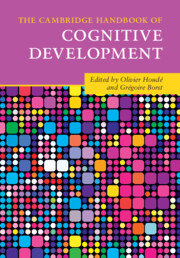Book contents
- The Cambridge Handbook of Cognitive Development
- The Cambridge Handbook of Cognitive Development
- Copyright page
- Contents
- Figures
- Tables
- Contributors
- Introduction
- Part I Neurobiological Constraints and Laws of Cognitive Development
- Part II Fundamentals of Cognitive Development from Infancy to Adolescence and Young Adulthood
- Introduction
- Subpart II.1 Infancy: The Roots of Human Thinking
- Subpart II.2 Childhood and Adolescence: The Development of Human Thinking
- Part III Education and School-Learning Domains
- Index
- Plate Section (PDF Only)
- References
Introduction
Assembling the Building Blocks of Cognition in a Non-linear Dynamical System of Development
from Part II - Fundamentals of Cognitive Development from Infancy to Adolescence and Young Adulthood
Published online by Cambridge University Press: 24 February 2022
- The Cambridge Handbook of Cognitive Development
- The Cambridge Handbook of Cognitive Development
- Copyright page
- Contents
- Figures
- Tables
- Contributors
- Introduction
- Part I Neurobiological Constraints and Laws of Cognitive Development
- Part II Fundamentals of Cognitive Development from Infancy to Adolescence and Young Adulthood
- Introduction
- Subpart II.1 Infancy: The Roots of Human Thinking
- Subpart II.2 Childhood and Adolescence: The Development of Human Thinking
- Part III Education and School-Learning Domains
- Index
- Plate Section (PDF Only)
- References
Summary
The scientific study of cognitive development in young children traces its roots back to Jean Piaget, a pioneer of this field in the twentieth century (Piaget, 1954, 1983). From infancy to adolescence, children progress through four psychological stages: (1) the sensorimotor stage, from birth to two years (when cognitive functioning is based primarily on biological reactions, motor skills, and perceptions); (2) the preoperational stage, from two to seven years (when symbolic thought and language become prevalent, but reasoning is illogical by adult standards); (3) the concrete operations stage, from seven to twelve years (when logical reasoning abilities emerge but are limited to concrete objects and events); and (4) the formal operations stage, at approximately twelve years (when thinking about abstract, hypothetical, and contrary-to-fact ideas becomes possible).
- Type
- Chapter
- Information
- The Cambridge Handbook of Cognitive Development , pp. 141 - 148Publisher: Cambridge University PressPrint publication year: 2022



